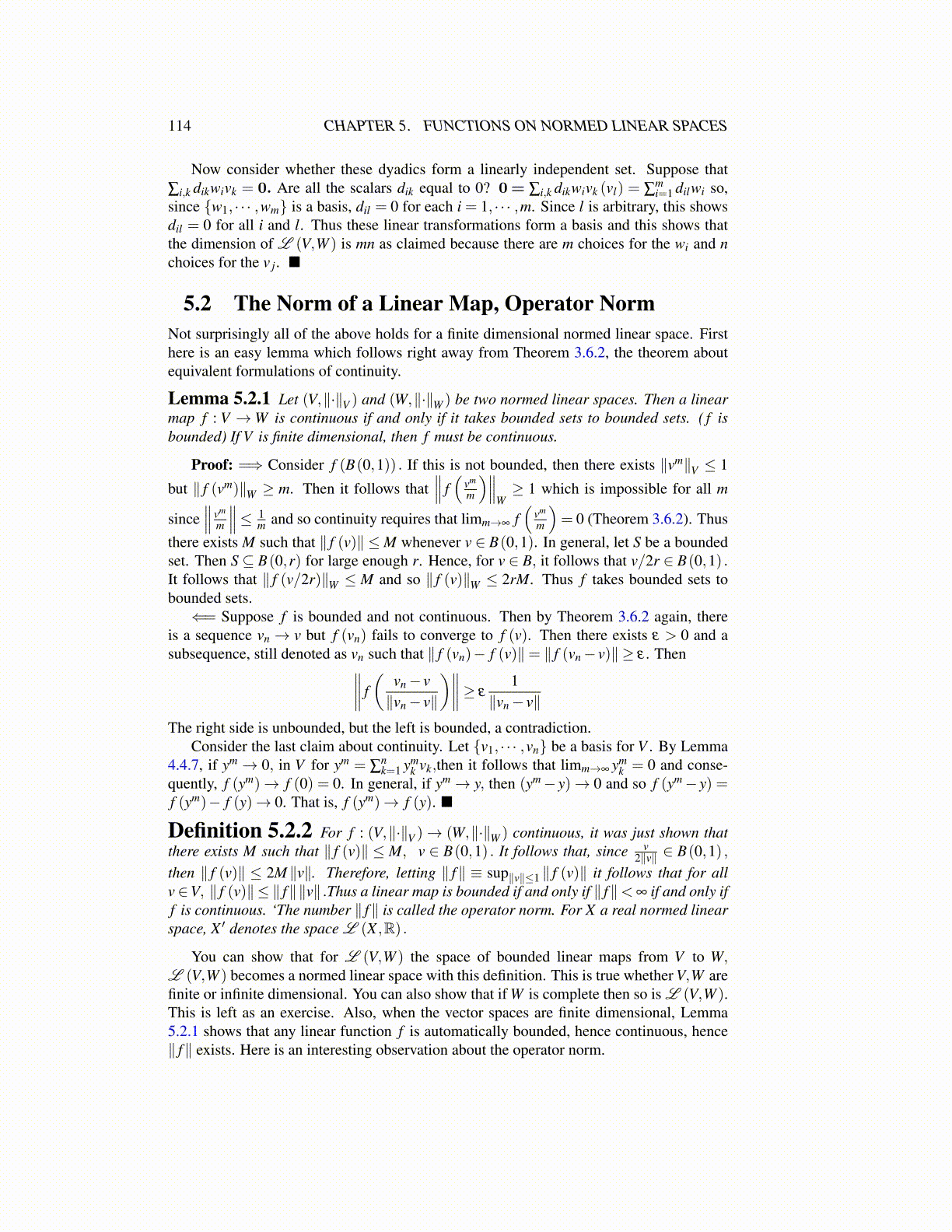
114 CHAPTER 5. FUNCTIONS ON NORMED LINEAR SPACES
Now consider whether these dyadics form a linearly independent set. Suppose that∑i,k dikwivk = 0. Are all the scalars dik equal to 0? 0 = ∑i,k dikwivk (vl) = ∑
mi=1 dilwi so,
since {w1, · · · ,wm} is a basis, dil = 0 for each i = 1, · · · ,m. Since l is arbitrary, this showsdil = 0 for all i and l. Thus these linear transformations form a basis and this shows thatthe dimension of L (V,W ) is mn as claimed because there are m choices for the wi and nchoices for the v j. ■
5.2 The Norm of a Linear Map, Operator NormNot surprisingly all of the above holds for a finite dimensional normed linear space. Firsthere is an easy lemma which follows right away from Theorem 3.6.2, the theorem aboutequivalent formulations of continuity.
Lemma 5.2.1 Let (V,∥·∥V ) and (W,∥·∥W ) be two normed linear spaces. Then a linearmap f : V →W is continuous if and only if it takes bounded sets to bounded sets. ( f isbounded) If V is finite dimensional, then f must be continuous.
Proof: =⇒ Consider f (B(0,1)) . If this is not bounded, then there exists ∥vm∥V ≤ 1
but ∥ f (vm)∥W ≥ m. Then it follows that∥∥∥ f(
vm
m
)∥∥∥W≥ 1 which is impossible for all m
since∥∥∥ vm
m
∥∥∥≤ 1m and so continuity requires that limm→∞ f
(vm
m
)= 0 (Theorem 3.6.2). Thus
there exists M such that ∥ f (v)∥ ≤M whenever v ∈ B(0,1). In general, let S be a boundedset. Then S ⊆ B(0,r) for large enough r. Hence, for v ∈ B, it follows that v/2r ∈ B(0,1) .It follows that ∥ f (v/2r)∥W ≤ M and so ∥ f (v)∥W ≤ 2rM. Thus f takes bounded sets tobounded sets.⇐= Suppose f is bounded and not continuous. Then by Theorem 3.6.2 again, there
is a sequence vn → v but f (vn) fails to converge to f (v). Then there exists ε > 0 and asubsequence, still denoted as vn such that ∥ f (vn)− f (v)∥= ∥ f (vn− v)∥ ≥ ε . Then∥∥∥∥ f
(vn− v∥vn− v∥
)∥∥∥∥≥ ε1
∥vn− v∥The right side is unbounded, but the left is bounded, a contradiction.
Consider the last claim about continuity. Let {v1, · · · ,vn} be a basis for V . By Lemma4.4.7, if ym → 0, in V for ym = ∑
nk=1 ym
k vk,then it follows that limm→∞ ymk = 0 and conse-
quently, f (ym)→ f (0) = 0. In general, if ym→ y, then (ym− y)→ 0 and so f (ym− y) =f (ym)− f (y)→ 0. That is, f (ym)→ f (y). ■
Definition 5.2.2 For f : (V,∥·∥V )→ (W,∥·∥W ) continuous, it was just shown thatthere exists M such that ∥ f (v)∥ ≤ M, v ∈ B(0,1) . It follows that, since v
2∥v∥ ∈ B(0,1) ,then ∥ f (v)∥ ≤ 2M ∥v∥. Therefore, letting ∥ f∥ ≡ sup∥v∥≤1 ∥ f (v)∥ it follows that for allv∈V, ∥ f (v)∥ ≤ ∥ f∥∥v∥ .Thus a linear map is bounded if and only if ∥ f∥< ∞ if and only iff is continuous. ‘The number ∥ f∥ is called the operator norm. For X a real normed linearspace, X ′ denotes the space L (X ,R) .
You can show that for L (V,W ) the space of bounded linear maps from V to W,L (V,W ) becomes a normed linear space with this definition. This is true whether V,W arefinite or infinite dimensional. You can also show that if W is complete then so is L (V,W ).This is left as an exercise. Also, when the vector spaces are finite dimensional, Lemma5.2.1 shows that any linear function f is automatically bounded, hence continuous, hence∥ f∥ exists. Here is an interesting observation about the operator norm.